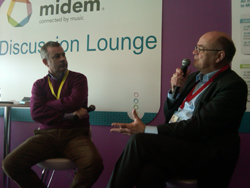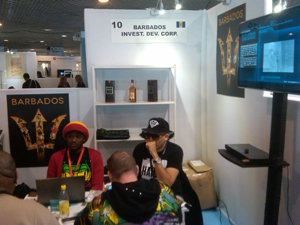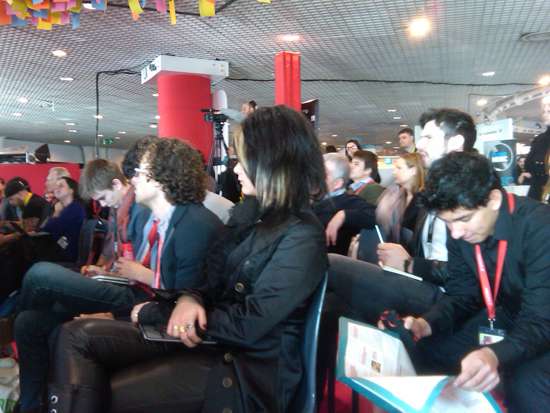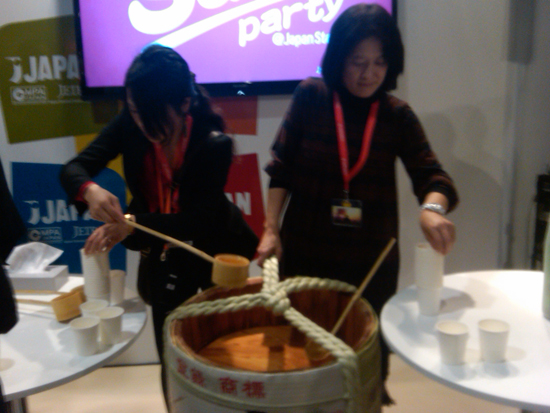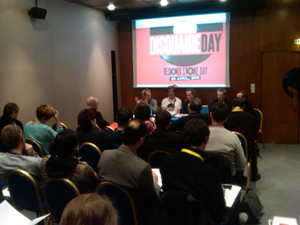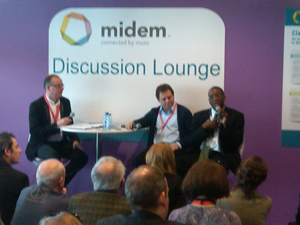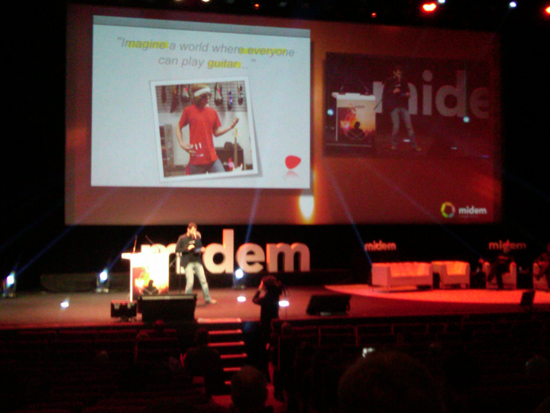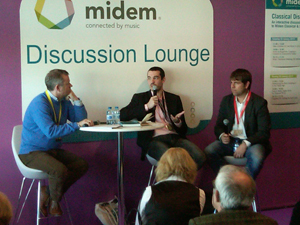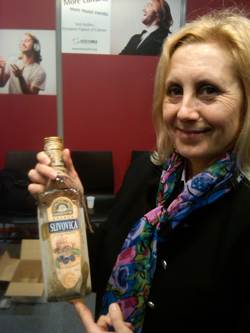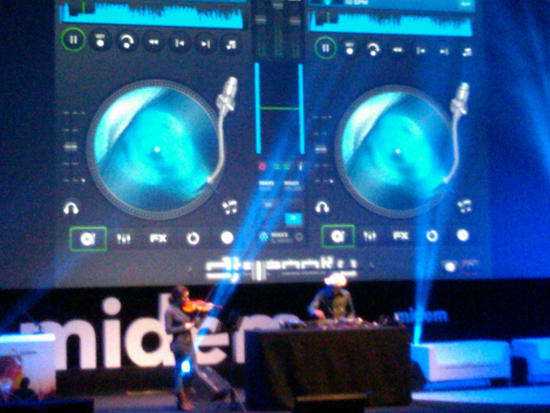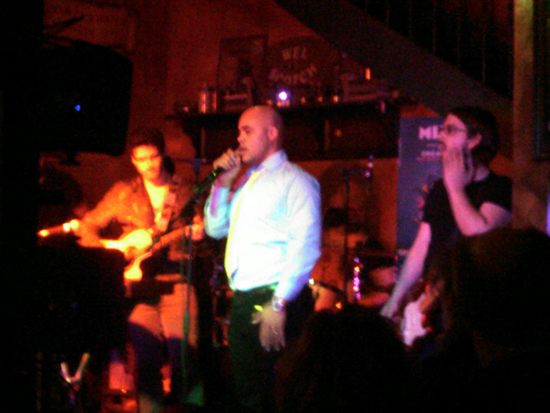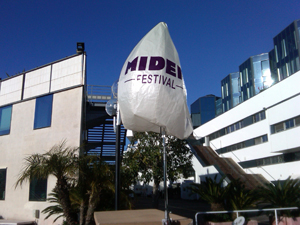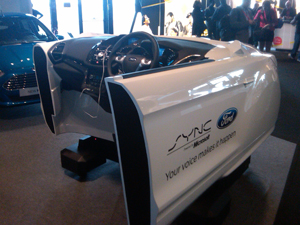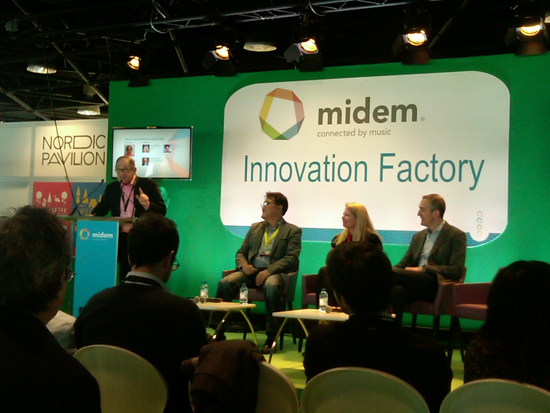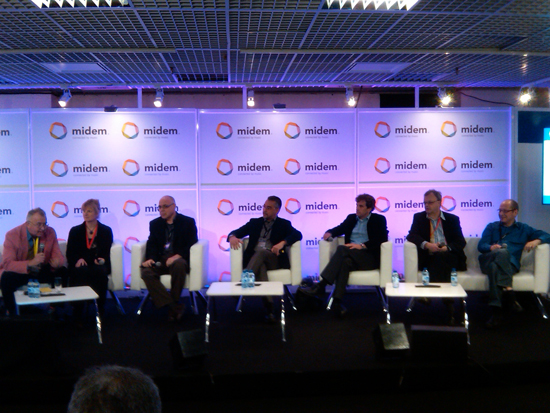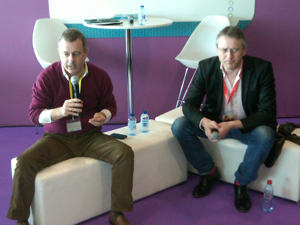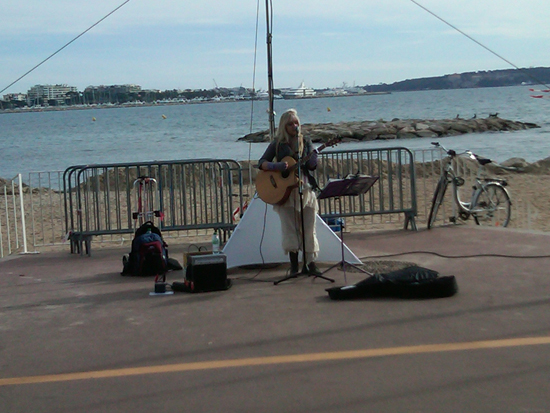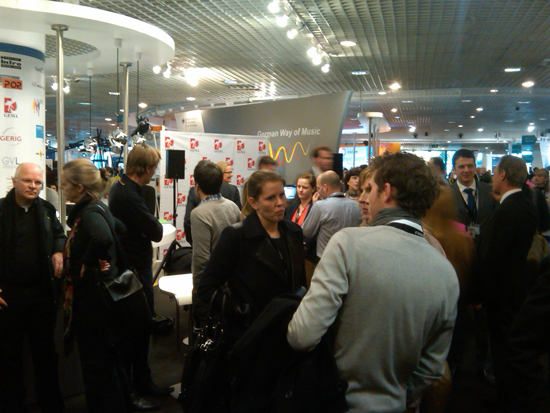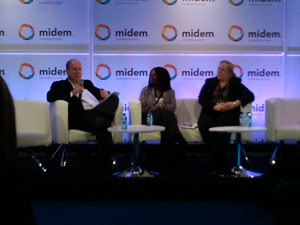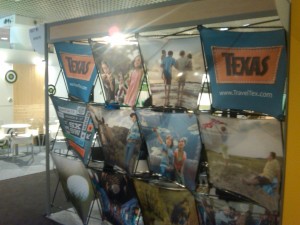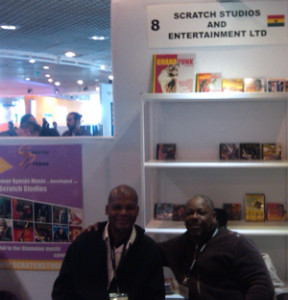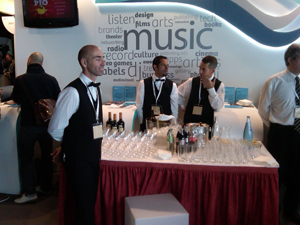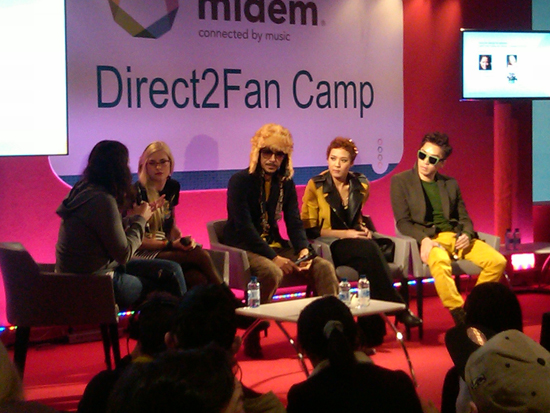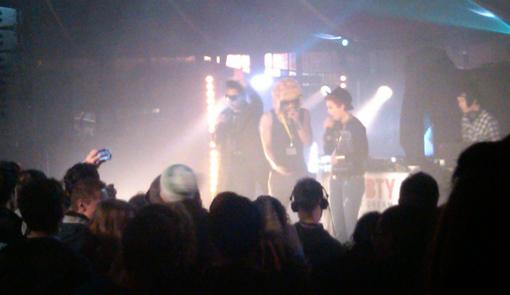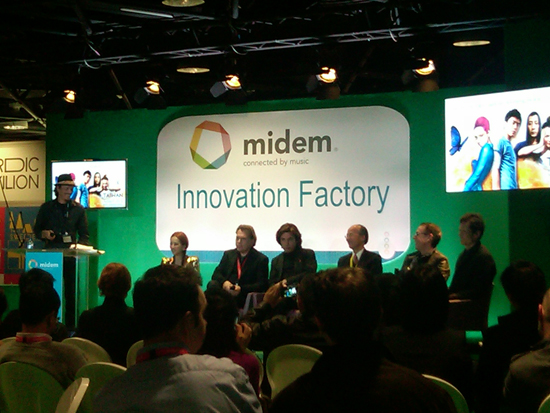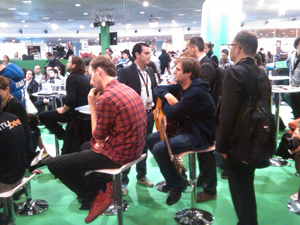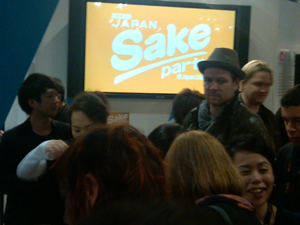This is the third consecutive year that I have attended MIDEM. After trying to figure out what exactly MIDEM is when I first attended two years ago and then returning to MIDEM the following year as an at least somewhat seasoned participant, I was expecting it to be much easier for me to navigate this time around, as well as to be able to more effectively process it and attempt to explain what it all means. But since MIDEM continues to transform itself, past experiences with this annual late January Cannes extravaganza only offer a partial cipher to its current incarnation.
A favorite refrain of longtime MIDEM veterans is that it used to be much larger, and the current event is but a pale shadow of the glory years; a reminder that the music industry is in its death throes. And certainly it has seemed smaller each year that I have attended; this year seems to have the smallest number of exhibitors thus far. But what began as a trade fair and a giant schmoozefest for exclusive members of the record industry from around the world, as well as folks who wished to join their ranks, has gradually transformed into something much more open and perhaps more valuable for the greater music community. And, as Rich Bengloff, President of the American Association of Independent Music (A2IM) points out, MIDEM is still “the most important music business convening in the world.” MIDEM has become a combination of a conference, a music technology expo, a summit for entertainment law, an exhibition (primarily populated by national music promotion organizations from around the world), and a music festival. And this year there has been a greater focus on classical music than in the two previous years I had attended. There are specific sessions addressing classical music (which does not always fit neatly with blanket music discussions from a pop music perspective) as well as specifically designated areas in the exhibition hall for meet and greets for the classical crowd. (It’s still a giant schmoozefest, after all.) This area is actually designated as being for classical music and jazz, but on day one I did not encounter any jazz-minded folks here; perhaps I will in the coming days.
I arrived in Cannes earlier than I ever had on Saturday morning (at 10:20am) and after rushing from the train station to leave my luggage at the budget hotel where I’m staying about three quarters of a mile away from the Palais des Conferences where MIDEM takes place (since I could not check in until 3pm), I ran to the Palais, quickly registered, and made it to the “Classical Discussion Lounge” in time for an 11am session—a conversation between Gramophone magazine’s Editor-in-Chief James Jolly and Nicholas Kenyon, managing director of London’s Barbican Centre entitled “New Initiatives for Live Music in 2013.” Both agreed that despite it being a tough time to market recorded music, live music is thriving. As Kenyon explained, “Live music is a shared experience.” He acknowledged that the Barbican has a huge advantage over other performing arts centres since it presents many different types of events, not just music performances, and as a result is able to bring different arts audiences together. But ultimately he asserted that there is only so far you can go with changing the traditional concert experience in order to attract new audiences: “You need to be able to concentrate since that’s what the music demands.” I’ve often believed that concentrated listening enhances the listening experience of music in any genre.
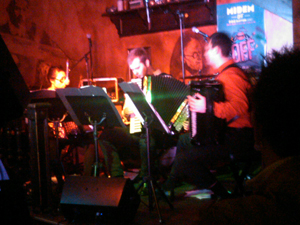
Trio Fidelio breaks with the post-Piazzolla sound world of the majority of their set to mine the soundworld of overlapping tone clusters.
Later that evening during a performance by the Trio Fidelio, a group of three accordionists who were the opening act for the Austrian showcase at Morrison’s Irish Pub, a group of English speakers next to me spoke loudly and incessantly, drowning out the music and ruining my ability to fully appreciate the post-Piazzolla romps that I was attempting to hear. After about fifteen minutes into their chatter, I moved to the other side of the room where it was slightly quieter. Perhaps the trio was aware of all the din because at one point they performed something that was a stark contrast to the rest of their set—following a primal scream from the leader of the group, they launched into a relentless series of tone clusters. Some folks walked out. I loved it, even though I did not find it at all shocking. But perhaps I was the one person there who had heard Patrick Hardish’s Accordioclusterville which William Schimmel recorded on a now long out-of-print LP on Ilhan Mimaroglu’s label Finnadar. (Someone needs to re-issue that recording.) But back to the events of the day…
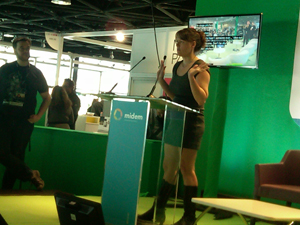
During the launch of MIDEM Hack Day, Emily White pitches an idea for a vinyl emulating hack for SoundCloud as Soundcloud’s Dave Haynes looks on.
At noon, I attended the launch of the 3rd edition of MIDEM Hack Day co-hosted by Martyn Davies of Hacks and Bants and Dave Haynes, vice president for business development at SoundCloud. Hackers from around the world are invited to create and build music applications using existing application programming interfaces (APIs). This year, a total of 27 hackers are involved in the project. They will be given only 45 hours in which to create their hacks and the results will be presented in a follow-up session on Monday morning. Stay tuned. During the launch, attendees were invited to pitch their ideas to the hackers. The most interesting of the ideas I heard was from U.S.-based artist representative Emily White who was interested in someone developing a hack for SoundCloud that would parse an album into A and B sides to emulate the division on a vinyl LP.
It was nice to hear such enthusiasm for vinyl at this year’s MIDEM, which in previous years seemed miles away from analog aesthetics. An even greater advocacy for vinyl, however, was a booth exhibiting the vinyl recorder, a machine which in real time records CD and mp3 tracks directly to vinyl. In the closing decade of the 20th century, folks were frantically replacing their LP collections with CDs; it’s nice to see that in the 21st century things are going the other way! For demonstration purposes, the exhibitors were recording single tracks onto vinyl from any attendee’s recordings and letting attendees keep the result. Of course, as a lifelong vinyl obsessive, this is something I had to have. I would not have wanted to make an unauthorized recording of someone else’s music, but luckily I had a CD in my pocket featuring some of my own music which I was giving to a friend later in the day. So I was able to test it out and now, at long last, I’m on vinyl—one copy at least.
I wandered around the exhibition area for about an hour; it’s always an opportunity to discover new music since many of the nations’ music promotion tables give away sampler discs of recent music from their respective countries. There were giant displays for J-Pop and K-Pop and music from countries all over Europe. Iran is not here this year (they were present both in 2011 and 2012), but Malaysia is here for the first time as is Barbados, and several countries from Africa (Ghana, Senegal, and Congo), although I have not yet had a chance to talk with them yet. Again, stay tuned.
Then I briefly attended a session at the MIDEM Academy called “International Publishing for Non-Publishers.” While the presenter, journalist Emmanuel Legrand, had a few interesting historical talking points (including the observation that publishing is the third oldest music-related business after performing and instrument building), he didn’t offer much information I didn’t already know. So I quietly left and ran across several atria to catch the Crowdfunding Workshop at the Direct2Fan Camp. Again, no real surprises here for me but it was the most heavily attended session I was at all day. Everyone wants to learn about getting money.
A session entitled “When Traditional Retailing Still Works” back at the Classical Discussion Lounge, however, offered much food for thought. BBC Radio 3 host Andrew McGregor led a lively discussion with Presto Classical Managing Director Chris O’Reilly and Nimbus Disc and Print Services Business Director Antony Smith. While everyone on the panel was still very attached to physical recordings, there was some disagreement as to their future viability. O’Reilly thinks he’s got another five years to sell CDs whereas Smith believes that CDs could still be around in 25 to 30 years. Smith does not really see digital downloads and streams as competition for CD sales as long as titles remain available in retail on physical formats since, according to him, “The recording industry has always operated on multiple platforms.” But Chris O’Reilly pointed out that sectors in the industry are forcing the transition to digital, such as the makers of tablets which do not include a CD drive and automobiles that are no longer equipped with a CD player, to which Smith countered, “My car doesn’t have an LP drive and LP sales are up.” Someone in the audience added that there seems to be a “deliberately inflicted downward spiral of physical sales; even though 60% of all U.K. sales are still physical, people are claiming there will be no physical sales in 2 years.” When Andrew McGregor mentioned that young people don’t collect, Smith had a retort for him as well. “Digital hasn’t been around long enough for us to know if they won’t become physical consumers. University students don’t want to own anything since they have to move around all the time, but after they graduate they go to IKEA and buy Billy bookshelves.” But aside from the clever banter, Smith probably had the most sage advice of the day: “If you buy recordings one at a time, the only efficient manufacturing is one at a time. Make the number you need as opposed to the number you think you might sell.” This, of course, is now possible, as on-demand reproduction is no longer financially prohibitive. Paradoxically, the same digital technology that threatens to eradicate physical recordings completely could fuel a new golden age for them as well.
My head was spinning at this point, but then it was time for more receptions. Traditionally the Japanese contigent always passes around free sake on the first night of MIDEM and this year was no different, so my head spun around even more…
Following a brief run to my hotel to finally check in officially and unpack my luggage, I ventured back outside to sample the various music showcases going on in clubs near the Palais. I already mentioned the Trio Fidelio. Following their set I headed over to the B. Pub to catch some of the Jamendo Showcase. You may recall my unease with Jamendo last year, since these are the folks who boast the largest amount of free legally downloadable music online but the price that artists who want to be on board have to pay is that they cannot be members of performing rights societies, which means that they forego their right to having someone advocate that their musical efforts will be financially remunerated. The Dutch band We Are FM, which combined very LOUD hard rock with occasional electronic bleeps and samples emanating from laptops, was a really solid act. I particularly liked one song’s refrain of “What would you do?” sung on a monotone over and over again. I also quite liked their very non-reggae cover of Bob Marley’s “is This Love?” which sounded part Music in 12 Parts-era Philip Glass and part Album-era Public Image Limited, although I wondered if the heirs of Bob Marley, who was a member of a performing rights society, were being remunerated for this performance.
Following We Are FM was the “YouTube sensation” Keelee Maize, a Pittsburgh-based rapper. At one point she shouted out, “So all of my music is free on Jamendo.” She has already four albums out as well as a book, all of which are also available on Amazon (where they presumably are not for free), so apparently she has found a way to make the promotion of Jamendo work for her. But after listening to about five of her songs as the crowd got bigger and bigger as well as louder and louder, I decided to head back to Austrian showcase to catch their closing act, Stereoface, an extremely assured hard-rocking quartet which was billed as a psych-pop-punk. They reminded me a bit of early Rolling Stones; the lead singer even looked slightly like a young Mick Jagger to me. But by then my eyesight was somewhat blurry; it had been a long day. As soon as their set ended, I finally went back to my hotel to get some sleep in preparation for another long day.


